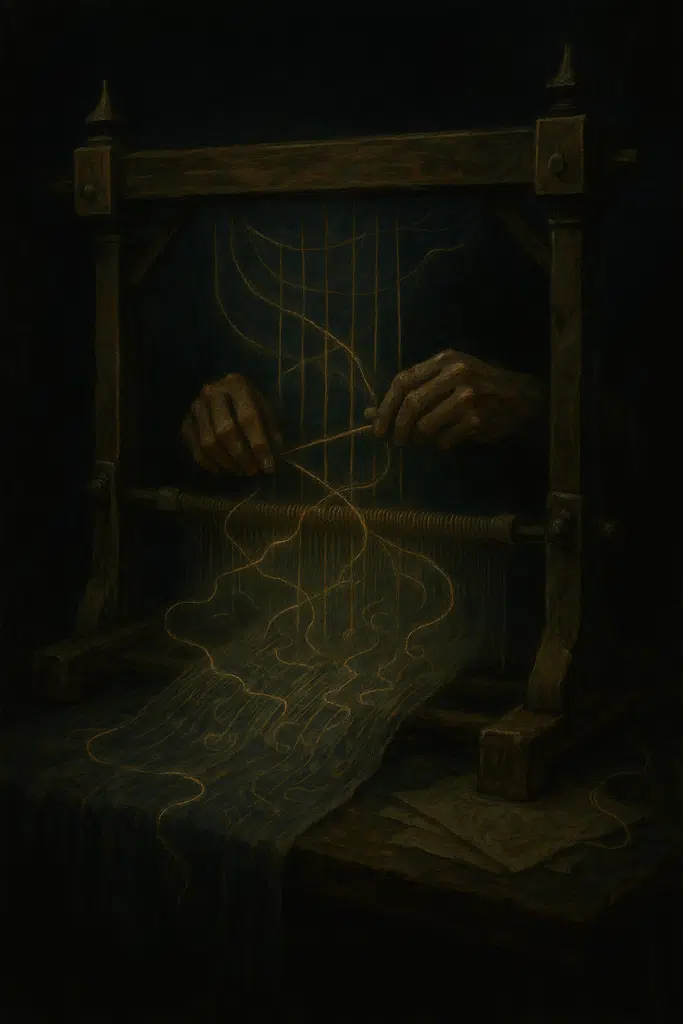Estimated Reading Time: 27 minutes (5170 words)
Character worksheets lie scattered across your desk, filled with eye colors, astrological signs, and favorite foods—yet your protagonist still feels like a cardboard cutout instead of a living, breathing person. The disconnect isn’t in your creative ability; it’s in your approach.
The most memorable characters emerge not from tallied traits or completed checklists, but from psychological excavation. When we shift our process from collecting facts to posing revelatory questions, we uncover the silent currents that shape human behavior—the contradictions, vulnerabilities, and unspoken desires that make fictional people feel authentically real.
Professional character developers understand this instinctively. They know that asking “What does your character believe they don’t deserve, but secretly want anyway?” generates more narrative potential than simply documenting their hometown or profession. One approach creates a file; the other creates a soul.
The difference matters because readers don’t fall in love with character sheets—they connect with the messy, imperfect humanity that emerges when you’ve asked questions that reach beyond surface attributes into the psychological bedrock beneath. This deeper investigation transforms character development from an administrative task into an act of discovery that energizes your entire storytelling process.
- Filling out checklists about your characters isn’t the same as truly knowing them. When writers shift from collecting character facts to asking psychologically revealing questions, their stories transform from collections of traits into explorations of authentic human experience.
- Prioritize motivation over mechanics: Instead of focusing only on what your character does, explore why they do it. Questions about motivation create the foundation for believable character actions that readers instantly connect with.
- Navigate the difference between traits and essence: Physical attributes and quirks are just the wrapping paper. Probe deeper by questioning how your character responds to ethical dilemmas, what they fear losing most, or which memories they revisit when alone.
- Organize questions by psychological function: Group your character inquiries by what they reveal—identity questions, relationship dynamics, value systems, and conflict responses. This structure creates a more comprehensive understanding than random lists ever could.
- Use questions as creative catalysts: The right question can unlock entire narrative arcs. Instead of asking “What does your character want?” try “What does your character believe they don’t deserve, but secretly want anyway?”
- Create conversation, not interrogation: Approach character development as a dialogue rather than a form to complete. Let one answer spark new questions, following threads of curiosity rather than checking boxes.
- Build question sequences that reveal contradictions: Characters become memorable when their inner conflicts emerge. Structure questions to reveal the gap between what they believe about themselves versus how they actually behave under pressure.
- Apply psychological depth with purpose: Every revealed aspect of character should serve your story. Questions that expose vulnerabilities or desires should connect directly to plot points where those elements will be tested.
Questions aren’t just tools for gathering information—they’re instruments of discovery that reveal the complex humanity within your characters. Let’s explore how to craft questions that transform flat characters into living, breathing people on the page.

The Psychology Behind Effective Character Questions
Moving from trivia to transformative inquiry
Character development often begins with the fundamentals: name, age, appearance, occupation. But these surface details, while necessary, rarely touch the psychological bedrock that makes fictional people resonate with readers. Transformative inquiry digs beneath these facts to unearth the psychological truths that animate a character from within.
When J.K. Rowling developed Harry Potter, she didn’t just decide he had green eyes and untidy hair. She questioned what it meant for a child to grow up unwanted, how early trauma shapes identity, and how the longing for belonging drives decisions. These psychological inquiries transformed Harry from a character concept into a person readers would follow through seven books.
Transformative questions focus on psychological patterns rather than isolated facts. Instead of asking “What is your character’s favorite food?” consider “What does your character seek comfort in, and why do they need that comfort?” The first question produces a fact; the second reveals a psychological pattern that can generate dozens of authentic character moments throughout your narrative.
Why surface details rarely create memorable characters
We remember Elizabeth Bennet not for her hair color but for her spirited independence in a society that demanded female compliance. We connect with Atticus Finch not because of his occupation but because of his moral courage and compassion. Surface details establish visual presence but fail to create the emotional resonance that makes characters linger in readers’ minds.
Characters constructed primarily from demographic data and physical traits tend to act according to plot necessity rather than psychological consistency. They become functional pieces moved around to serve the story rather than living entities whose authentic responses create the story. The most wooden characters in fiction are often those fully described yet psychologically hollow.
Research in literary psychology suggests readers form deeper connections with characters whose inner lives reflect recognizable human complexity. We remember characters who surprise us while remaining true to their core—a balancing act that requires understanding not just what they do, but why they do it. This understanding comes not from cataloguing traits, but from questioning the underlying psychology that would produce such traits in the first place.
The Motivation Beneath the Action
Uncovering the invisible drivers of behavior
Every meaningful character action is like the visible portion of an iceberg—what readers see is supported by a massive structure of motivations beneath the surface. These motivations range from conscious desires to unconscious compulsions, from rational goals to irrational fears. The writer who understands this substructure can create characters whose actions feel both surprising and inevitable.
Consider Severus Snape’s consistently cruel treatment of Harry Potter. On the surface, we see spiteful behavior. But the motivations beneath—his unrequited love for Harry’s mother, his bitter rivalry with Harry’s father, his complex loyalties—transform his actions from mere meanness into something richly complicated. His behavior makes psychological sense even when it seems contradictory.
Questions that uncover these drivers might include: “What past experiences taught this character that this behavior was necessary for survival?” or “What does this character believe will happen if they don’t take this action?” These inquiries reveal not just what motivates characters, but how they’ve come to be motivated in this particular way.
Questions that reveal what characters truly want versus what they pursue
Characters, like real people, rarely pursue what they most deeply want. A character might chase wealth when they truly crave respect. Another might seek power when they actually hunger for safety. This gap between surface pursuit and deeper desire creates the psychological tension that drives compelling narratives.
Effective character questions distinguish between instrumental goals (what characters actively pursue) and terminal goals (what they ultimately hope these pursuits will bring them). Ask not just “What does your character want?” but “What does getting this thing mean to them?” and “What do they believe this achievement will heal or solve in their life?”
Walter White in “Breaking Bad” pursued money through manufacturing methamphetamine, but what he truly wanted was to reclaim his masculinity and power after feeling emasculated by illness and financial hardship. This distinction between his surface pursuit and deeper motivation created the psychological complexity that made the character unforgettable.
Finding the gap between stated goals and emotional needs
The most revealing character moments often occur in the space between what characters say they want and what their emotions reveal they need. This gap exists because characters, like real people, rarely have perfect self-awareness. They develop protective narratives that obscure their genuine emotional needs even from themselves.
Questions that probe this gap include: “What emotional need is your character unable or unwilling to acknowledge?” and “What would your character be terrified to discover about themselves?” or “What truth about themselves are they working hardest to disprove?”
Jay Gatsby claimed to want Daisy Buchanan, but what he truly needed was to validate his self-created identity and erase his past. His pursuit of Daisy was really a pursuit of his own idealized self-image. This gap between his stated romantic goal and his deeper identity crisis creates the tragic dimension that elevates “The Great Gatsby” beyond a simple love story.

Beyond Traits: Excavating Character Essence
The limitations of physical and behavioral checklists
Physical and behavioral traits provide useful shorthand for readers to visualize and recognize characters, but they often fail to capture what makes a character distinctive on a deeper level. A character might be identified by her nervous habit of twirling her hair, but this trait alone doesn’t reveal why we should care about her journey.
Checklists tend to flatten characters into collections of quirks rather than cohesive personalities. A writer might dutifully note that a character loves jazz, hates cilantro, and bites his nails, but these disconnected traits don’t necessarily form a meaningful psychological whole unless they connect to something essential about who the character is.
The problem intensifies when writers use trait checklists as a substitute for deeper development. The resulting characters often feel like assemblages of random characteristics rather than organic beings with coherent inner lives. They become recognizable but not knowable—identified by their surface features but opaque in their essence.
Probing ethical frameworks and personal values
Characters become truly distinct when we understand not just what they do but how they judge—both themselves and others. A character’s ethical framework reveals what they believe makes a life well-lived, what constitutes success or failure, and what actions they consider beyond the pale.
Questions that excavate this ethical dimension include: “What would this character consider unforgivable?” “What virtue do they pride themselves on most?” and “What moral compromise would cause them the most shame?” These inquiries reveal the standards by which characters measure themselves and others.
Captain America and Iron Man in the Marvel Universe share heroic traits, but their ethical frameworks diverge dramatically. Steve Rogers operates from principle-based ethics that value adherence to moral absolutes, while Tony Stark employs consequentialist reasoning that justifies means by ends. This fundamental difference in how they judge right action creates authentic conflict between characters who both want to do good.
Questions that expose what characters protect at all costs
At their essence, characters are defined by what they would never willingly sacrifice. These non-negotiable elements might include relationships, principles, self-perceptions, or possessions. When narrative pressure threatens these protected values, characters reveal their true nature.
Effective questions include: “What would this character never give up, even to save their own life?” “What lie about themselves do they protect at all costs?” and “What part of themselves do they refuse to acknowledge or examine?” These questions reveal a character’s innermost sanctuary—the place where their truest self resides.
In “Les Misérables,” Jean Valjean protects his moral transformation at enormous cost. When he could remain silent and allow another man to be punished in his place, he chooses to reveal his true identity because he cannot sacrifice the hard-won redemption that defines his essence. This moment crystallizes who Valjean is at his core through what he refuses to compromise.
Structuring Questions by Psychological Function
Identity formation questions: Who they believe they are
A character’s self-concept forms the foundation of their psychology. How they view themselves shapes every decision, relationship, and response to challenge. Identity questions probe how characters have constructed their sense of self and what threatens this construction.
Effective identity questions include: “What story does this character tell about who they are?” “What identity labels do they embrace or reject?” and “What past experience most shaped how they see themselves?” These questions reveal not just who characters believe themselves to be, but how they came to this belief.
The protagonist of “A Man Called Ove” defines himself as competent, righteous, and unfoolable. This self-concept stems from his working-class upbringing and early responsibilities. When circumstances challenge this identity—when he cannot fix things or control outcomes—his entire sense of purpose collapses. His suicidal impulses arise not from circumstance but from identity crisis: if he is not the capable fixer, who is he?
Relationship dynamic questions: How they connect and disconnect
Characters exist in webs of relationships that reveal their attachment patterns, trust thresholds, and emotional availability. How they connect with others—and how they maintain distance—offers profound insight into their inner landscape.
Powerful relationship questions include: “How does this character test whether someone is trustworthy?” “What behavior would end a relationship for this character?” and “What role does this character habitually play in close relationships?” These inquiries reveal patterns that transcend individual connections.
Don Draper in “Mad Men” forms relationships characterized by emotional withholding and periodic abandonment—patterns established in his childhood. He connects through performance rather than vulnerability, recreating the conditional acceptance of his youth. Understanding these patterns explains why he repeatedly sabotages intimacy despite longing for it.
Value system questions: What they judge in themselves and others
A character’s value system functions as their internal compass, directing their judgments and evaluations. These values may be conscious principles or unconscious biases, but they consistently influence how characters assess situations and people.
Questions that illuminate value systems include: “What quality does this character admire most in others?” “What personal failing triggers their harshest self-judgment?” and “What achievement would make them feel their life was worthwhile?” These inquiries reveal what matters most to characters beneath their stated preferences.
Hermione Granger values intellectual achievement and rule-following because these provide structure and validation in a world where her Muggle-born status makes her vulnerable. Her judgment of others often centers on their respect for knowledge and authority—values that make her feel secure. This value system explains both her strengths and her blindspots throughout the Harry Potter series.
Conflict response questions: Where their vulnerabilities lie exposed
How characters respond to conflict reveals their deepest vulnerabilities and defense mechanisms. These patterns often operate outside conscious awareness, triggering automatic responses when characters feel threatened or challenged.
Illuminating conflict questions include: “What criticism would wound this character most deeply?” “How does this character respond when cornered?” and “What conflict strategy did this character learn in childhood?” These inquiries expose the tender spots characters protect and the ways they armor themselves.
When faced with conflict, Walter White from “Breaking Bad” responds with escalating aggression because vulnerability threatens his fragile self-image as the one who provides and protects. His hypersensitivity to perceived disrespect reveals his core wound: the belief that his worth depends on dominance and control. This conflict response pattern drives the series’ escalating violence.

Questions as Narrative Catalysts
How the right question can generate entire plot arcs
The most powerful character questions don’t just reveal character—they generate story. When a well-crafted question exposes a psychological fault line in a character, the answer often suggests a narrative journey that forces the character to confront this vulnerability.
Consider the question: “What truth about himself is this character working hardest to deny?” For Michael Corleone in “The Godfather,” the answer—that he is his father’s true heir in temperament and talent—suggests his entire character arc. The narrative becomes a progressive confrontation with this denied truth, culminating in his complete transformation into what he once rejected.
Questions about contradictory desires naturally suggest plot conflicts. If your protagonist simultaneously craves belonging and fears vulnerability, this contradiction generates situations where these desires come into direct conflict. Each choice the character makes deepens one desire while frustrating the other, creating escalating tension that drives narrative momentum.
Reframing standard character inquiries for deeper revelations
Standard character questions can be reframed to yield psychological insight rather than surface information. Instead of asking “What is your character’s job?” ask “What does their work allow them to believe about themselves?” Instead of “What is their greatest fear?” ask “What do they believe would happen to them if this fear came true?”
These reframed questions transform information-gathering into psychological exploration. They reveal not just the what but the why, connecting external details to internal meaning. A character’s occupation becomes significant not for its tasks but for how it reinforces or challenges their self-concept.
When Arthur Conan Doyle created Sherlock Holmes, he didn’t just make him a detective; he created a character whose work perfectly satisfied his need to prove his exceptional intellect. Holmes’ career choice reveals his core psychological need for validation through intellectual performance. This connection between external occupation and internal need creates a psychologically coherent character.
Using contradictory answers to create internal conflicts
Characters become most compelling when their answers to key questions contain internal contradictions. These contradictions create psychological tension that drives authentic character development. A character might simultaneously value honesty and engage in self-deception, or crave intimacy while pushing others away.
Questions that probe these contradictions include: “What does your character claim to value that their actions undermine?” and “What desire does your character pursue that conflicts with their deepest fear?” The answers reveal the unresolved tensions within characters that make them feel authentically human.
Tony Soprano exemplifies these contradictions: he values family loyalty above all else yet repeatedly betrays his own family; he seeks therapy to address his anxiety while actively avoiding genuine self-awareness; he craves respect while engaging in behavior he himself considers dishonorable. These contradictions create the psychological complexity that made “The Sopranos” revolutionary television.
The Dialogue Approach to Character Development
Creating conversational pathways instead of interrogations
Effective character development resembles an organic conversation more than a formal interrogation. Rather than marching through a predetermined list of questions, writers can follow the natural flow of discovery as one question’s answer suggests the next area to explore.
This conversational approach creates space for surprise. Just as we discover unexpected aspects of real people through meandering conversations, writers often make their most significant character discoveries when following curiosity rather than checklist logic. The character might “say” something unexpected that opens entirely new territories of exploration.
Writers using this approach might begin with a seed question—”What does this character believe they’re entitled to?”—and let the answer guide subsequent inquiries. If the answer reveals an outsized sense of entitlement, follow-up questions might explore the origins of this belief, how others respond to it, and situations that challenge it. This creates a discovery process that feels more like getting to know a person than filling out a form.
Following threads of curiosity rather than completing forms
Curiosity-driven character development follows emotional and psychological threads wherever they lead, rather than seeking to complete a comprehensive profile. This approach honors the mysterious nature of personality and allows characters to reveal themselves gradually, sometimes reluctantly.
Writers might notice a peculiar response to a situation and become curious: “Why would this character react this way?” This question might lead to exploring formative experiences, psychological wounds, or value conflicts that explain the unexpected reaction. Each answer deepens understanding while potentially raising new questions.
This spiraling exploration resembles how we come to understand real people. We notice patterns, become curious about inconsistencies, and gradually piece together a deeper understanding. The resulting character knowledge feels discovered rather than invented—organic rather than constructed.
How one answer naturally suggests the next question
In natural conversation, responses contain clues that suggest productive follow-up questions. Similarly, in character development, a character’s answer to one question often contains psychological threads worth following into deeper territory.
If asking about a character’s relationship with their father produces the answer “He always said I had potential,” this response suggests several natural follow-up inquiries: “How did this assessment affect the character’s self-image?” “What does the character believe their father meant by ‘potential’?” “How has the character tried to live up to or reject this description?”
This approach creates a psychological logic that connects disparate aspects of character. A character’s career choice connects to their relationship with authority, which links to their conflict responses, which reveals something about their core wounds. These connections emerge not from imposing structure but from following the inherent psychological patterns that make characters coherent.

Designing Question Sequences That Reveal Complexity
Layering questions to uncover inconsistencies
Strategic question sequencing can reveal illuminating inconsistencies in how characters understand themselves. By approaching the same psychological territory from several angles, writers can uncover gaps between a character’s self-perception and their actual patterns.
A revealing sequence might begin with “What does your character believe is their greatest strength?” followed later by “What do others regularly criticize about your character?” and finally “When has your character’s supposed strength actually created problems?” These triangulating questions often reveal blind spots and self-deceptions that create dimensional characters.
In “Pride and Prejudice,” Elizabeth Bennet prides herself on her discernment and judgment of character. Yet her assessments of both Wickham and Darcy prove catastrophically wrong. This inconsistency between her self-perception (excellent judge of character) and her actual capability (vulnerable to flattery and prejudice) creates the psychological journey at the heart of the novel.
Exploring the tension between self-perception and behavior
Characters, like real people, often maintain self-perceptions that their actual behaviors contradict. This gap between who they believe themselves to be and how they actually behave creates productive psychological tension that drives development.
Questions that probe this tension include: “What virtue does your character claim to embody?” followed by “When has your character failed to live up to this virtue?” and “How does your character explain away this contradiction?” These inquiries reveal the psychological gymnastics characters perform to maintain their self-image.
Throughout “Mad Men,” Don Draper sees himself as exceptional and above common morality, yet repeats the same self-destructive patterns as those he judges. His awareness of this contradiction emerges gradually through the series, creating moments of painful self-recognition that punctuate his character development. The tension between his exceptional self-image and his all-too-human behaviors drives much of the series’ psychological drama.
Questions that illuminate character growth potential
Characters become dynamic when writers identify the psychological learning they most need but most resist. Questions that reveal this growth potential focus on what psychologists call the character’s “growing edge”—the developmental frontier where their current limitations meet their future possibilities.
Productive questions include: “What truth would most destabilize your character’s worldview?” “What emotional capacity does your character lack that would transform their relationships?” and “What belief does your character cling to that no longer serves them?” These questions identify the psychological territory where meaningful growth can occur.
In “A Christmas Carol,” Scrooge’s growing edge involves reconnecting with his capacity for compassion and joy—emotional abilities he once possessed but systematically suppressed. The ghosts force him to confront precisely the truths he has most vigorously denied: that wealth provides no comfort, that relationships give life meaning, and that his current path leads to a lonely death. By targeting his specific resistance points, the story creates authentic transformation.
Connecting Character Depth to Story Structure
Aligning psychological revelations with plot turning points
Psychological insights about characters gain power when revealed through plot events rather than exposition. The most effective narratives align significant psychological revelations with key structural moments, creating turning points that simultaneously advance both character development and plot.
In “The Remains of the Day,” Stevens the butler’s devastated realization that he has sacrificed love for an unworthy professional loyalty coincides with the structural climax. This alignment amplifies both the emotional impact of his psychological revelation and the narrative significance of the plot event. The character insight and story structure reinforce each other.
Questions that facilitate this alignment include: “What situation would force this character to confront their most deeply held belief?” and “What external challenge would make this character’s internal contradiction unsustainable?” These inquiries help writers design plot events that naturally trigger essential psychological revelations.
Using character vulnerabilities to generate authentic obstacles
A character’s psychological vulnerabilities naturally suggest the obstacles most likely to challenge them. Rather than imposing random difficulties, writers can design challenges precisely calibrated to engage a character’s specific weaknesses, fears, and blind spots.
For a character who fears abandonment, the plot might repeatedly test their relationships, forcing them to risk rejection to achieve their goals. For a character who needs control, circumstances might increasingly demand surrender and trust. These psychologically tailored challenges feel inevitable rather than arbitrary.
Questions that generate authentic obstacles include: “What situation would trigger this character’s deepest fear?” “What task would require them to use their least developed capability?” and “What choice would create direct conflict between their conscious values and unconscious needs?” These inquiries produce obstacles that test characters precisely where they’re most vulnerable.
How deep questioning naturally suggests narrative tests and challenges
The psychological patterns revealed through character questioning naturally suggest the tests a character must face to achieve growth. Each significant insight about a character’s limitations, fears, or contradictions suggests a corresponding challenge that would force confrontation with this aspect of themselves.
If questioning reveals a character who equates vulnerability with weakness, the narrative might force them into situations where strength requires vulnerability. If exploration uncovers a character who sacrifices authenticity for approval, the plot might present increasing costs for this pattern until maintaining it becomes impossible.
This approach creates what mythologist Joseph Campbell called “the hero’s journey”—a path that systematically challenges a character’s psychological limitations and defenses. By designing challenges based on psychological insights rather than external conventions, writers create narratives that feel both surprising and inevitable.

The Art of Character Contradiction
Why internal conflicts create the most compelling characters
Characters defined by internal contradiction captivate readers because they mirror the complexity of human experience. None of us is psychologically consistent; we all contain conflicting desires, contradictory beliefs, and competing values. Characters who embody these contradictions feel authentically human rather than artificially coherent.
These internal conflicts create dramatic tension even in quiet moments. A character simultaneously drawn toward adventure and security experiences conflict regardless of which they choose. A character who both craves and fears intimacy creates dramatic possibilities in every relationship. These contradictions generate ongoing psychological drama that keeps readers engaged.
Questions that uncover productive contradictions include: “What does this character simultaneously crave and fear?” “What principle do they uphold that conflicts with their emotional needs?” and “What do they want that they also believe they don’t deserve?” These inquiries reveal the psychological cross-currents that make characters fascinating.
Questions that expose competing desires
Every compelling character contains multiple, sometimes contradictory desires that cannot be simultaneously satisfied. These competing wants create necessary choices that reveal character through which desire ultimately takes priority.
Effective questions for uncovering competing desires include: “What does your character want that conflicts with something else they want?” “What two values do they hold that sometimes contradict each other?” and “What desire would they be ashamed to acknowledge alongside their nobler aspirations?” These inquiries reveal the competing motivational forces within a character.
In “The Great Gatsby,” Jay Gatsby desires both Daisy Buchanan and the complete erasure of the five years they spent apart. These desires eventually conflict, as having the real Daisy would require acknowledging the years she spent with Tom and the daughter they produced. His refusal to reconcile these competing desires—his insistence that she declare she never loved Tom—ultimately destroys his dream and himself.
Finding the psychological fault lines where characters break open
Characters reveal themselves most profoundly when circumstances force their internal contradictions into the open. These moments—when competing desires can no longer be reconciled, when cherished beliefs collapse, when self-deceptions fail—create psychological breaking points where characters must transform or shatter.
Questions that identify these fault lines include: “What belief is so essential to your character’s self-concept that losing it would create an identity crisis?” “What contradiction could they acknowledge only under extreme duress?” and “What situation would force them to choose between core aspects of their identity?”
In “Breaking Bad,” Walter White’s fault line emerges when his scientific brilliance and need for recognition conflict with his self-image as a family man and moral person. As these contradictory aspects of his identity become increasingly irreconcilable, he breaks open, revealing the true priorities and values he had denied even to himself. This psychological fracture creates the devastating power of the series’ conclusion.
Practical Application in Your Writing Process
Integrating question-based development into your workflow
Question-based character development can be incorporated at various stages of the writing process, from initial conception to final revision. Rather than treating character development as a separate preliminary activity, writers can integrate psychological questioning throughout their workflow.
During initial development, broad psychological questions help establish a character’s foundational patterns: “What do they want that they can’t have?” “What do they believe about themselves that isn’t true?” These questions create a psychological sketch that suggests promising narrative directions.
While drafting, more specific questions can address emergent issues: “Why would this character make this particular choice in this moment?” “What are they afraid might happen if they chose differently?” These targeted inquiries solve specific character problems while deepening overall understanding.
When to revisit questions throughout the drafting process
Character understanding evolves throughout the writing process, making periodic return to key questions valuable at different stages. Early drafts often reveal new aspects of characters that weren’t visible during initial planning, necessitating fresh rounds of questioning.
After completing a first draft, writers might revisit fundamental questions about motivation: “Now that I’ve seen this character in action, what do they truly want?” “What pattern in their behavior didn’t I consciously plan?” These reflective questions often reveal subconscious insights that emerged during drafting.
During revision, questions can target specific character inconsistencies or flat points in the narrative: “Why does this character’s response here feel inauthentic?” “What deeper motivation might make this moment more psychologically compelling?” These surgical inquiries focus on strengthening specific aspects of character development.
Transforming answers into scenes that show rather than tell
The insights gained through psychological questioning become most powerful when transformed into scenes that demonstrate character truth through action, choice, and conflict rather than exposition. Effective writers create situations that naturally reveal the psychological patterns they’ve discovered.
To show a character’s deep-seated fear of abandonment, a writer might craft a scene where they preemptively reject someone to avoid being rejected—showing the pattern in action rather than explaining it. To demonstrate a character’s conflicting desires for both attention and authenticity, a scene might force them to choose between these values under pressure.
The most revealing scenes often place characters in situations that force them to prioritize between competing values or desires. A character who claims to value family above career becomes most clearly defined when circumstances force them to choose between these priorities. These moments transform psychological insight into dramatic action that engages readers while revealing character truth.
Characters aren’t puzzles to solve, but mysteries to explore—each question you ask opening a door to another room of possibility. As you set aside the checkbox mentality and embrace a more curious approach to character creation, you’ll find yourself no longer writing about people, but discovering them instead. The questions that make you uncomfortable as a writer often lead to the truths that make your readers unable to look away. In that delicate space between knowing and wondering lies the alchemy that transforms words on a page into souls that linger long after the story ends.






